Dr Alan McOwan, lead clinician at 56 Dean Street, explains why the Soho sexual health clinic has launched the Dean Street Fitness Programme and we talk to fitness instructor Taofique Folarin who puts us through our exercises in videos for the Dean Street fitness challenge. Check out the Dean St Fitness Challenge at dean.st/fitness
People are often surprised when we tell them that 56 Dean Street has launched a fitness programme. So why are we doing it? Well the foundation of a great sex life is a healthy body and mind.
We all want to have more energy and look great. Most people know that a healthy diet and a combination of aerobic and weight bearing exercise will reduce your body fat and build lean muscle. But exercise isn’t just about chiselled pecs and a six pack.
Stress, anxiety and depression are all more common in gay men. It’s an issue that comes up regularly at the clinic. Physical activity has been proven to boost wellbeing. It does it by improving the levels of dopamine and serotonin in your brain. This can reduce feelings of anxiety and stress. Your levels of endorphins are also increased, improving your mood and reducing the perception of pain. Some studies suggest that regular exercise is as effective as taking antidepressant medicines. The benefits don’t stop there, it’s also linked to improved memory, learning and reduces the risk of schizophrenia and dementia.

Regular physical activity also improves higher sexual functioning. If you have low self-esteem it’s harder to express what you want from a sexual encounter. That can lead to choices you later regret. A positive mood and outlook helps you have the confidence to stay in control and get the sex you want.
Increased activity improves your sexual desire, function and performance. Muscle strengthening exercises optimise testosterone levels, which can boost your sex drive. The improvement in your blood circulation increases energy levels, stamina and encourages stronger, longer lasting erections. There’s clear evidence that regular exercise decreases the risk of erectile dysfunction.
It can also help insomnia. Being active during the day helps you fall asleep faster and have deeper, better quality sleep. Just don’t exercise too close to bedtime as the endorphin rush can keep you awake. The bottom line is that you’re likely to feel happier, calmer, have an improved self-image and a better sense of wellbeing if you’re physically active.
Staying active is also great for your physical health. The levels of inflammation chemicals in your body are reduced, helping prevent a whole host of medical problems. It improves your blood pressure and increases the levels of good cholesterol in your blood. This helps protect against diabetes, heart disease, stroke, metabolic syndrome and autoimmune illnesses.
But the benefits don’t stop there, it also reduces your risk of bowel cancer, and some studies suggest it may reduce the risk of lung and prostate cancer too. The improvement in muscle tone helps support joints, which reduces your risk of arthritis. If you already have osteoarthritis it can reduce pain and increase your function and range of movement.
The UK Academy of Medical Royal Colleges describes exercise as the ‘miracle cure’. Physical activity is safe and beneficial for almost everyone. A common mistake is to try to take on too much at once. So listen to your body, start slow and build up the intensity over the next few days if you find it too easy. Don’t overdo it on the first day then give up. Ask your doctor first if you have very high blood pressure or significant heart, circulation or lung problems.
It doesn’t take much to benefit your health. People who are active for as little as 15 minutes a day can expect to live 3 years longer than those who do no exercise. So even if the Dean Street Fitness Programme isn’t for you, we’re challenging you to make 2020 the year you get more active.
What’s
recommended?
150 minutes of ‘moderate intensity’ exercise every week. Moderate intensity includes anything that increases your heart rate and breathing, making you feel warmer. e.g. 30 minutes on 5 days per week. Try and include muscle strengthening exercises on at least 2 of them.
Examples of moderate
intensity exercise:
Brisk walking/cycling/jogging
Weights/Exercise Bands
Body-weight training such as push ups
Swimming/Rowing/Team sports
Dancing
Having sex
Check out the Dean St Fitness Challenge at dean.st/fitness

Total Body workout from the Dean Street Fitness Programme
Try this sample workout from the Dean Street Fitness Programme. If you’re new to exercise, aim to do each move for 30 seconds with 3O seconds recovery between them. Don’t worry if you can’t complete it. There’s always tomorrow. What matters is that you keep on trying. Visit dean.st/fitness for this and other workout videos.
Plank Walk Out

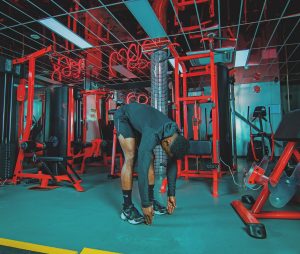
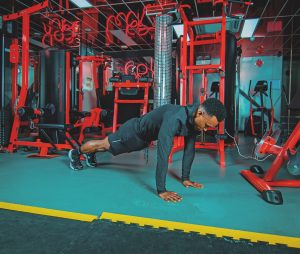
Raise your arms above your head. Reach down to the floor. Walk your hands out into a plank position, then back again towards your toes and stand rolling through the spine. Repeat.
Alternating Reverse Lunges
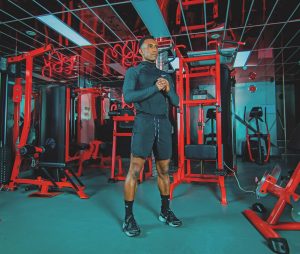
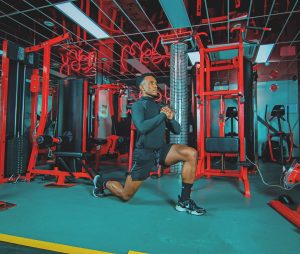
Take a big step back. Make sure your front knee is in line with the ankle. Push back up through your front heel into a standing position again. Squeeze the glutes at the top. Repeat, alternating legs each time.
Squat Jacks
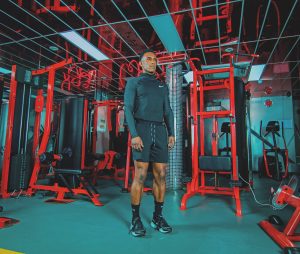

Start from a standing position with your feet together. Jump out, reaching down to your right ankle with your left hand at the same time. Keeping the weight in your heels and your glutes low, jump back into the starting position, squeezing your legs together at the top. Alternate sides.
Push Ups
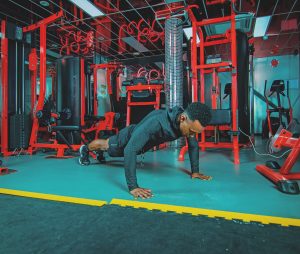
Your hands should be wider than your shoulders. Point your elbows back 45 degrees from your body (a common mistake is to keep them in line with the shoulders). Lower your chest to the floor and back up. If you’re new to push ups try it with your knees on the floor.
Mountain Climbers
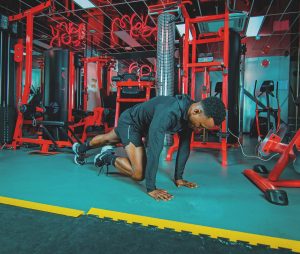
Start in a plank position (Make sure your shoulders are directly over your wrists). Pull your right knee towards your right wrist then back out again as fast as possible. Keeping your knee as close to the floor as you can. Alternate sides.
Military Plank
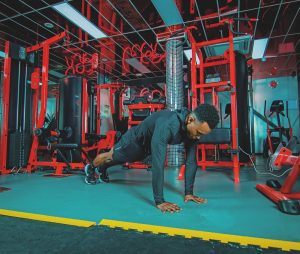

Start in the plank position as before. Keeping your abs and glutes tight, go down onto your forearms then back up again. Switch the arm you start with each time. Trying to keep your hips as still as possible throughout. For more stability keep your feet slightly apart.
Shoulder Push ups
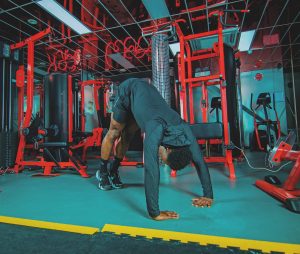
Starting from a plank position, walk your feet in so that your bum is in the air (Downward dog position). Your fingers should be pointing towards each other. Lower your head down to the floor bending the arms, then push back up again. If you’re new to this, try it with your knees down.
High Knees

Run on the spot. Bring your knees up high to waist level. Keep your chest high, abs tight and drive your arms.
Half Burpees

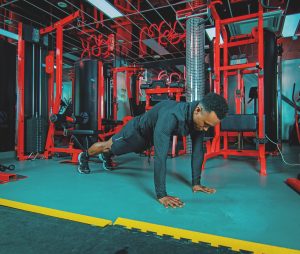
From a standing position, jump back into a plank. Spring back in and stand. Repeat. The more advanced can try lowering the body down to floor after the plank to then stand.
Russian Twists
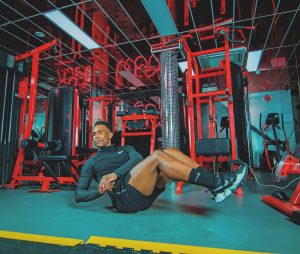
Sit on the floor and lean back 45 degrees. Rotate your entire torso and head alternately left and right, breathing out each time. Once you’re more experienced, try lifting your feet off the floor. Keep your chin lifted away from the chest.
Photos by Joel Ryder.
Thanks to Sweatbox gym and sauna for the photoshoot location.
Check out the Dean St Fitness Challenge and the videos at dean.st/fitness














